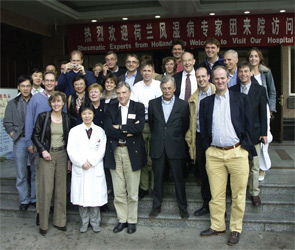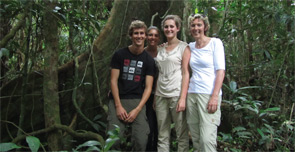“From our perspective,” Dr. Kvien says, “she is not only a very brilliant person, but she is very organized, and always on time.” She and her oldest daughter have spent time at Dr. Kvien’s cabin in the Norwegian mountains. There they have taken hikes, climbing up to 5,184 feet. “That’s very unusual, you know, for Dutch,” he jokes. He admires his colleague’s curiosity and willingness to try new things. “So, although she’s always organized and delivering, it’s always in a friendly and relaxed way,” he says.
Colleagues and trainees alike admire Dr. van der Heijde’s productivity. Despite a full travel schedule and double appointments at both Leiden and Oslo, she manages to monitor her trainees’ projects and stay involved with the numerous society and organizational initiatives with which she is involved. “She is very focused, and there is not a better planner in the world,” says Dr. Landewé.

Ida Haugen, MD, would second that notion. Currently conducting research for her thesis on magnetic resonance imaging (MRI) in osteoarthritis at Diakonhjemmet Hospital, she appreciates Dr. van der Heijde’s availability and her facility with developing scoring systems, an additional challenge when using MRI because of the density of data in images. “If you have a question and don’t really know what to do, she understands really quickly what the problem is,” Dr. Haugen says. “She has a clear answer about how to proceed and you can continue with the rest of the work.”
Spondylarthritis and outcomes research have been Pedro Machado’s primary research interest, so when it came time to choose a fellowship program in 2008, he looked to Tom Huizinga’s center of excellence at Leiden University Medical Center, in the Netherlands. Knowing that Dr. van der Heijde, a spondylarthritis expert, had an appointment there “made the choice quite easy,” he says. He began work on his PhD thesis in 2010 and is focusing on health outcomes and imaging in axial spondylarthritis. He’s found Dr. van der Heijde’s advice particularly valuable, since knowledge about outcomes research is central to his work. “I think it’s important that you admire your supervisor’s work, and I think you have to find that work exciting, in order for the relationship to work out,” Dr. Machado observes. “For me, Désirée is such a person.”

Rewards and Future Challenges
As a young researcher, Dr. van der Heijde had the chance to meet an established American rheumatologist whose work she not only knew and admired, but had adapted for the Nijmegen early arthritis cohort. She was presenting her data from the RA study in poster form at the ACR Annual Scientific Meeting when John Sharp, MD, approached her. “That,” she recalls, “was the beginning of a very nice working relationship and friendship.” From the first publication of the van der Heijde modification of the Sharp score, Dr. van der Heijde has continued to refine and explicate this important radiologic assessment so core to assessing damage in RA. She and Dr. Sharp worked together for many years on different projects, until the year of his death in 2008. Both were part of a core subcommittee on healing of erosions in RA, taking the assessment process to a qualitatively new level.5 “It was always very stimulating to work with him, and I always listened very carefully to his commands because they were always important,” she says.